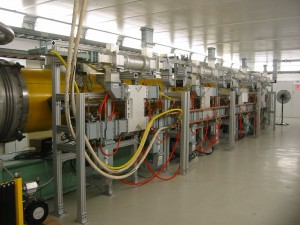Cryomodule 1 is now firing on all eight cavities.
Cryomodule 1, Fermilab’s test cryomodule for ILC-type accelerating cavities and superconducting radiofrequency (SRF) technology, was powered up as a complete, multi-cavity instrument earlier this month. Previously, researchers had delivered power only to the individual cavities inside it.
“We’ve operated superconducting cavities before, but this is the next step in scale,” said Sergei Nagaitsev of Fermilab’s Accelerator Division. “Operating a single cavity in its own cryostat is comparable, but with a full cryomodule, the complexity goes up by an order of magnitude.”
Since the cool-down of CM1 last November, scientists, engineers and technicians have been busy installing the plumbing for power distribution, called waveguides; upgrading the water skid, which helps with the cooling of the high-power RF equipment; and taking data on each cavity’s accelerating gradient and quality factor, or Q. Researchers completed the cavity tests in June.
“The big question now is how this module performs compared to when the cavities were at DESY,” said Fermilab’s Elvin Harms. The German physics lab DESY provided all eight CM1 cavities, which were tested before they came across the Atlantic. Over the coming weeks, researchers will continue to feed power into cryomodule to gather data on how cavities perform as a single unit rather than as individual elements. The hope is that their gradients and Q will be in reasonable agreement with DESY’s numbers.
To make sure the data that comes through is reliable, the CM1 team will work on calibrations, test RF power operation, and work the kinks out of the system. Then comes a multi-week programme where scientists will perform stability tests and beam studies for the ILC beam current programme, which includes tests that can be conducted without the presence of beam. Researchers will also use CM1 for tests for Project X, Fermilab’s proposed proton accelerator programme.
Not all sailing was smooth in the time since the November cool-down. Some cavities still have wrinkles that need to be ironed out.
“Nevertheless, the fact that the integration of it all into a single system worked is a tremendous boost for the Accelerator Division, the Technical Division and our collaborators,” Nagaitsev said.
Collaborators on CM1 include researchers from DESY, INFN in Italy and KEK in Japan.
“Many people have invested a lot of time in CM1,” Harms said. “They’ve been eagerly waiting to get this to this day.”


If all else fails, you can turn on that floor standing fan! /s
SLAC also collaborated, providing processed couplers and the rf distribution system, with specially designed components ;^).
Thank you, Chris! I regret the oversight. DESY, Fermilab, SLAC – collaboration across continents and coastlines.